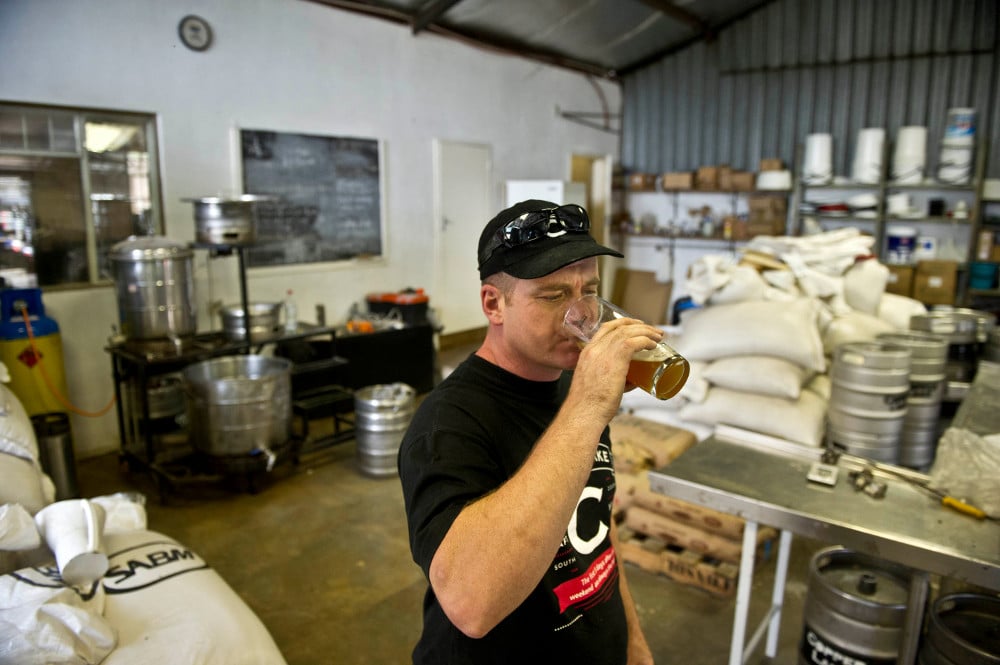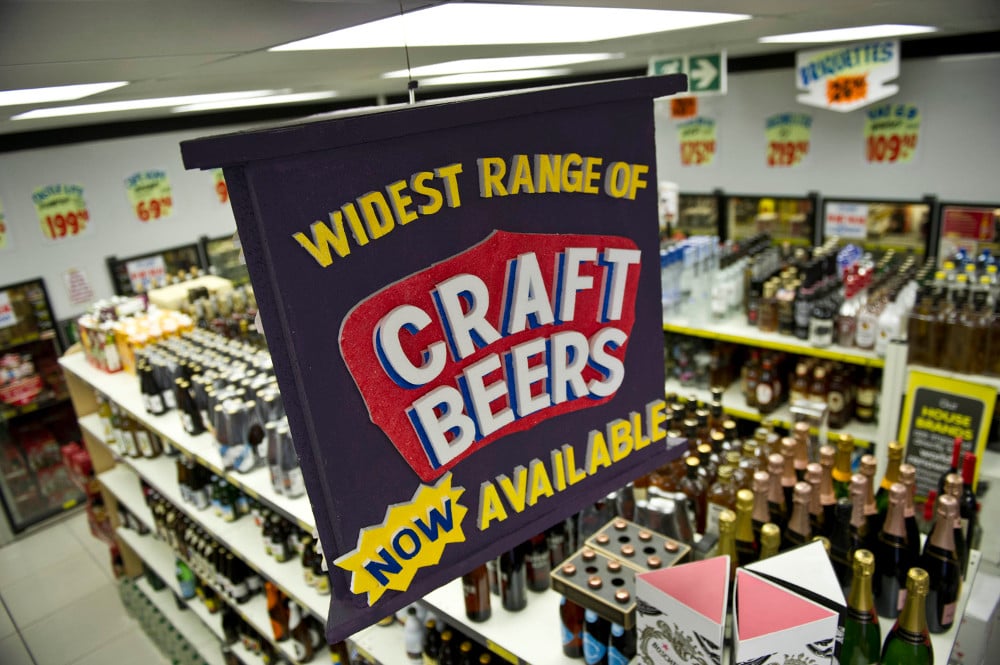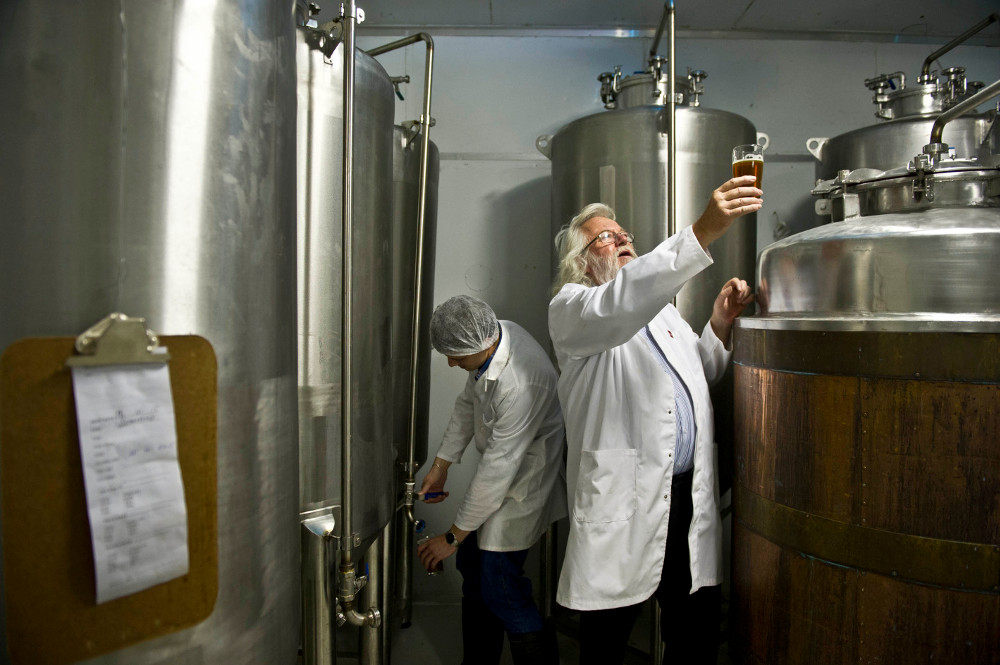brewers warn that a festive season prohibition will negate any recovery in the sector
We’re inside the Copperlake Brewing Company brewpub in Johannesburg’s Broadacres, all standing around a home-made brewing system, experiencing an increasingly popular way to spend a weekend – guest brewing.
This feast of motley brewers ranges in age from their mid-twenties to mid-sixties, and each has a confident opinion on the beer in their hand, or what’s being brewed – but, regarding the home-made brewing system in front of them, it’s pure curiosity.
Mounted on the wall is what looks like a household geyser wrapped in copper, with buttons and switches to control the temperature of the water that will be used to boil and flush during the brewing process. Pipes run into the mash tun, which is a large 100-litre pot, also wrapped in copper and sitting on top of a gas burner. More pipes run from there into a second pot and back again.
The owner and designer, Brendan Watcham, helps the brewers get used to his system, but tries not to be hands-on during the brewing. Sporting a black, company T-shirt with the slogan, “Because milk never solved any problems!”, Watcham is considered a modern pioneer in the booming craft beer industry.
Copperlake covers the cost of the ingredients and, after being fermented back at the brewery in Lanseria, the “guest brew” goes on sale under the brewer’s name several weeks later, alongside Watcham’s own range of beers.
This is craft beer, the antithesis to the global domination of the same boring old beers. Some might say the antidote. Although holding only 6% of the global beer market may sound more like an ant challenging an elephant to a duel, the craft beer revolution is part of a worldwide trend away from mass production back to artisanal food, drink and other goods.
The real uptake of craft beer locally began in 2012, when The League of Beers, an online distributor of craft beers, was founded by Rob Heyns.
He likes to joke that his business idea triggered the explosion in demand that happened the following year, but he’s a little more humble. “We just got the timing right, saw what was starting to happen and perhaps nudged it along.”
It did appear to happen almost overnight. The trendiest new thing, almost a rite of passage now, was to be seen with a cloudy, foamy ale and one’s nose buried deep into the glass and making some highfalutin comment about citrus and floral notes with an underlying hint of bubblegum. In Cape Town and Johannesburg’s main restaurant strips, craft beer bars were suddenly claiming prized real estate.
“It was no longer Castle and Hansa on tap, but Darling Slow Beer, CBC, Jack Black, Johnny Gold Weiss,” Heyns tells me, adding that his business is based on getting South African lager lovers to understand the complexities and intricacies of craft beer, and ultimately to become more discerning.
When it comes to craft beer, there are several pioneers around the country. Mitchell’s Brewery in Knysna and the Nottingham Road Brewery in the KwaZulu-Natal Midlands are regarded as the most significant early runners from the 1980s and 1990s.
“Most people, though, are not so enamoured with the price,” says Heyns, although I did not need him to point that out. Craft beers can often be two, three or four times the price of regular beers. But he is quick to defend what many call greedy brewers. “Craft beer appears to have all the margin, but looks can be deceiving.”
Down to basics
It comes down to three simple factors: logistics, economies of scale and quality. Beer is a heavy and fragile item, so logistics is the biggest factor. It’s all about getting the right beer to the right place, at the right time, in the right quantities and in the right condition.
When you look at economies of scale, you’re comparing a few hundred litres for young craft breweries with tens of thousands by the heavyweights. That comes into play on ingredients, bottling, labelling, marketing and distribution. Quality is where it all becomes a little more subjective.
According to the views of visitors canvassed at a Johannesburg craft beer festival, the Western Cape’s revolution seems to be further ahead than Gauteng’s, because, “like, Cape Town is just so much more with it, bro”; “people in the Cape have always been exposed to more wine so it’s a natural transition for them” (the more practical possibility); and “because it’s just so much easier to get a licence in Zilleville” (which truly caught my attention).
Three years ago, Watcham was a home brewer, turning out an impressive 300 litres a month. Today, his Copperlake Breweries is producing 20 000 litres a month, and even that is falling behind demand.
“We just keep the tanks full; we can’t go wrong if we’re keeping the tanks full,” he tells me as he points out three new 10 000-litre fermentation tanks soon to be installed. This will increase the output of his brewery on a small-holding near Lanseria, allow him to distribute to even more parts of the country, and to meet the surging demand at his Broadacres brewpub.
Above all, Watcham is a serious and focused businessperson, and what sets him apart is that he’s a metallurgical engineer and plumber. It gives him a distinct advantage because, besides the home-made system at the brewpub, he builds all his own brewing systems. Most others spend a fortune importing them from overseas or buying them secondhand from another brewery that has either expanded or gone bust.
Watcham ran several metalworks businesses. When I ask what made him switch, he cheekily remarks: “Alcohol dependence. It always helps when you have an addictive product. You’ll never miss a day’s work.”
He loves beer but says he didn’t realise it until he started brewing his own.
“I had tried brewing as a school boy, but it was Wort Hogs that turned it for me. I had been at Steve Gilroy’s [brewery in Gauteng] for a bachelor’s party, saw a web link for the club and joined in 2007. That’s where I learnt everything about beer.” (See below)

Copperlake’s brewpub gives would-be brewers a chance to develop their own beer and even markets it for them. (DSC)
Making that change meant, among many other things, applying for a liquor licence. For Watcham, this would be a micro-manufacturing licence, which allows you to brew up to 100-million litres of beer each year. To put that in perspective, one of the highest-by-volume craft breweries, the Cape Brewing Company, turns out an average three million litres a year.
“There’s a long list of crazy things you have to do,” Watcham says, showing me the entrance to the property. “We even welded lugs on the gates so Sars [South African Revenue Service] can add a padlock and lock us out if they need to.”
Brendan is serious about compliance; he doesn’t want to risk a criminal record. “Where we were clever though is using rivets for the fridge, so at least we could pop that off, take out the stock and replace the lock.”
Like almost everyone starting out, Watcham tried to navigate the licensing labyrinth himself, but says he quickly saw it as an impossible task. “I couldn’t even find the right person or get the forms I needed.”
There are three main steps to getting a licence to brew beer commercially, which falls under different categories depending on the province. In Gauteng, first, it’s getting all the documentation together, such as a business plan, site map and location plans, zoning specifications, health and safety notices, police clearance and Sars tax certificates. Once these are submitted and provisionally checked, they will be sent to a central office.
The second step is inspections and objections. An inspector is supposed to visit the premises within two weeks, although this seldom happens, and they are expected to phone beforehand to notify the applicant of their arrival, which is also rare. Once done, that inspection gets added to the applicant’s file.
At the same time notices have to be placed in local newspapers to give the public a chance to comment or object. These, too, are added to the file.
Step three is when it all comes together before the liquor board. Applications are heard in chronological order, grouped with similar types, such as transfers or new licences.
“Most of the board’s time, though, is not spent on hearing applications,” says Jurie Zietsman, a liquor licence specialist. The primary bottleneck taking up the board’s time “is matters filed by the inspectorate or SAPS [South African Police Service] against existing licence holders who have transgressed. That’s like a mini-court session, and you can imagine how each case can take ages,” says Zietsman. “They really need a tribunal just for those cases, and keep applications separate.”

Craft beer makes up 6% of the global beer market.
The Western Cape appears to have recognised this and could be making changes along these lines, when an amendment to the provincial Liquor Act, which makes provision for three new adjudicators, is expected to be signed into law by year-end.
Zietsman believes the Western Cape, where he primarily operates, has better systems, but the board there sometimes asks for too much detail, which can make it difficult for applicants to comply. “But it is clear. They issue regular guidelines, which Gauteng doesn’t do, and communication with consultants is emphasised, so that helps a lot.”
Copperlake Breweries also battled for nearly two years before going the legal route. Watcham says the irony is brewers are dealing with one department, Sars, which is efficient, while the other is useless. He doesn’t completely dismiss the obstacles he has had to overcome. “It’s most definitely a barrier to entry, so, competitively, once you have it, it’s not that bad. I was at least running another business, which sustained me.”
Cases such as his, if awarded costs, can cost the taxpayer between R60 000 to R100 000 a time. They’re fought under the Promotion of Administrative Justice Act, which deals with transparent and judicious decision-making.
Reaching the right representative of the Gauteng Liquor Board is no easy task and, despite several attempts to get a response to these allegations, I was unsuccessful.
Specialists like Zietsman thrive on the existence of chaos. “We’re even developing our own software to handle anything bureaucratic, not just liquor licences. But we need to beat the departments to it so the general public uses us and gets used to it. If government systems get organised and operate entirely online, we will be faced with quite a challenge. However, as long as there are application processes, human nature will create a demand as people are always looking for someone to help.”
He says the application process largely depends on the number of staff and their attitude. “We complain as much as everyone else, as it adds to our workload and not necessarily our bottomline. However, every additional document which is required, complicating the process, makes our position more secure.”
Legal changes
That process is about to become even more onerous if new national liquor law proposals, currently open for comment, are passed. The proposals, which will have a direct effect on patrons and businesses, will include changes to opening hours, restricting traders’ proximity to residential spaces and public transport, placing the responsibility of intoxication on the sellers of alcohol, and increasing the legal drinking age to 21.
A new Act was adopted by Gauteng in 2013 but has yet to be promulgated by the minister of economic development. “In theory that should improve things as there is a better, more modern, combination of licences.”
The numbers do suggest a skew. Last year, there were about 20 craft breweries in Gauteng, the smallest province that is home to a quarter (more than 12-million) of the country’s population. The Western Cape’s population is half that but it has twice as many craft breweries.
The reality is that many factors come into play and it would be unfair to pin that skew on licensing alone. But bureaucracy does get in the way. Without it, or with less of it, perhaps there would be more craft breweries. Besides more choices of beer, it would mean an increase in jobs, taxes and economic development.
Competition is fierce, with the number of craft breweries rocketing from a handful in 2010 to well over a hundred in a few years. Although brewers still compare notes and have formed long-lasting friendships through their early days of home-brewing clubs, it’s each brewer for himself in this latest round of battle of the breweries.
The real-life adventures of a brewer
Steve Gilroy’s company slogan is “120 years behind the times!”. So if anyone is likely to have been through all the licensing difficulties it would have to be him. This mad godfather of South African brewing insists I must go through his beer experience tour before he’ll share his insights, promising me it’s nothing like the brewery tour I had been on in 2004.
Gilroy’s has moved from Roodepoort to a plot in Muldersdrift, shared with the Ngwenya Glass factory and several shops. It has expanded to become a significantly larger brewery, a bar and restaurant, as well as a shop selling Gilroy Ales and general beer paraphernalia.
Gilroy stands more than 1.83m tall, has a mane of silver hair falling just short of his shoulders, glasses balancing on a glowing red nose, and a sense of humour that’s challenging to engage if you’re not quick enough with an equally sharp-witted response. Everything about Gilroy is dramatic – part Monty Python, part Shakespeare, part David Attenborough.
In a metronomic tone, Gilroy first delivers an overview of what beer is made from and the audience settles into his stride as he changes the tempo and pushes on with his story. “We got our brewing licence on the first of April 2000. I wasn’t sure if it was an April Fool’s joke for the new millennium. Now we were legal. It took the fun out of it. It’s like driving sober. Where’s the challenge?”
Gilroy is on a personal quest to convert South Africans to craft beer – and to his in particular.
“The commercial brewers say, ‘Drink it freezing cold!’ Of course they do – they’re terrified of you tasting it!”

The craft beer industry is hampered by red tape, through which Steve Gilroy of Gilroy Brewery has blazed a pioneering trail. (DSC)
When we finally sit down to discuss the licensing issues involved in moving to their new premises and expanding the business, his brewery manager, Michael Biljon, hands me a CD and says: “Here, just listen to this, it will tell you everything you need to know.”
Five months previously, Gilroy had been asked to participate over the phone in a radio discussion on CliffCentral.com about licensing. The show begins with a basic exchange of pleasantries and explanation of who Gilroy is. Then, Gilroy takes over.
“This is a story of ineptitude, corruption, fear, pettiness, stupidity and horror. Oh what horror! And also sex when you consider what the government was trying to do to us at the time …” The presenters are giggling, unsure of how to respond. They don’t need to. Gilroy is in control.
Without consulting the show producers, Gilroy and Biljon had written a comedic script for the two of them to act out live on air, telling the farcical licensing journey Gilroy had endured. Sound effects are dropped in at regular intervals to bring the story to life, and the James Bond theme tune is playing softly in the background.
“He’s running his own show,” the producer whispers with admirable concern through an open mic.